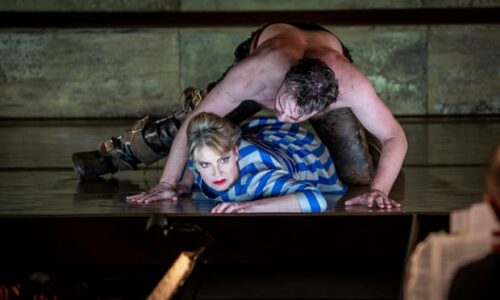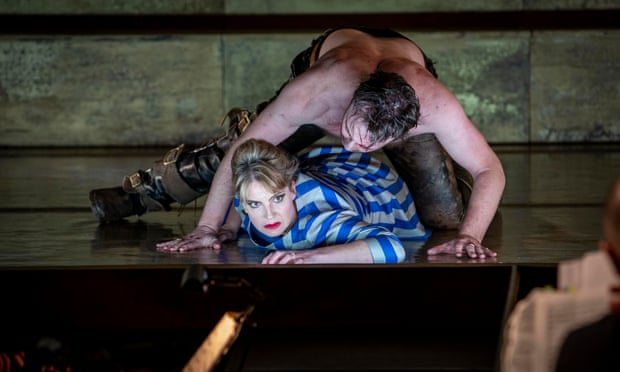 United Kingdom Vivaldi, Bajazet: Soloists, Irish Baroque Orchestra / Peter Whelan (director). Linbury Theatre, Royal Opera House, Covent Garden, 7.2.2021. (CC)
United Kingdom Vivaldi, Bajazet: Soloists, Irish Baroque Orchestra / Peter Whelan (director). Linbury Theatre, Royal Opera House, Covent Garden, 7.2.2021. (CC)

Production:
Director – Adele Thomas
Costume & Set Designs – Holly O’Cathain
Fight Director – Kev McCurdy
Lighting Design – Sinéad Wallace
Movement Director – Sarita Piotrowski
Cast:
Bajazet – Gianluca Margheri
Tamerlano – James Laing
Asteria – Niamh O’Sullivan
Andronicus – Eric Jurenas
Irene – Claire Booth
Idaspe – Aoife Miskelly
Confined within the same walls, violence, rancour … Covid lockdown fallout, anyone? Adele Thomas’s staging of Vivaldi’s Bajazet for Irish National Opera seen here at the Royal Opera House’s Linbury Theatre is incredibly powerful. A lot was riding on this regarding the future of Vivaldi productions in London – this was the first of his operas to be staged at the Royal Opera House. A massive ceiling hook dominates the stage – Bajazet spends most of his time attached to it, subjected to various types of cruelty (just one miscalculation of Tamerlano’s punch, too obviously staged). From the start, violence is present – we even see Tamerlano urinating (with his back turned to the audience) on Bajazet.
We met Adele Thomas’s superb direction skills before in Handel’s Berenice in 2019 (review click here), whose cast also included Claire Booth. Here, it was the stark, powerful simplicity that was so impressive, a canvas upon which Sinéad Wallace’s lighting could at times create the most remarkable impact as well as allowing for the visual variety.
With a performance of Theodora already underway upstairs in the Royal Opera’s main space, it was clearly Baroque Night at the Garden. Of course, while Handel’s operas are very much the flavour of the moment, Vivaldi’s have endured centuries of neglect. Performances like this ask us why this might be so, as well as positing answers. Ensembles are minimal; there is no chorus. And Bajazet is a pasticcio opera, which means we have inserts from composers such as Hasse, Giacomelli and Broschi. On paper, this might seem to conspire against the piece; the reality was very different. This run of Bajazet, itself preceded by a string of performances in Ireland, is a major event.
First performed in Verona in 1735, Vivaldi’s opera Bajazet tells of the fallout of the defeat of the Ottoman Emperor Bajazet by the Turco-Mongol conqueror Tamerlano (perhaps better known generally as Timur and historically known for what Thomas calls his ‘hyper-violence’ as decapitator of whole villages, the heads then arranged ‘in perfect pyramids’).
Musically, the sheer energy of Vivaldi’s music never lets up; and neither did the energy of the players of the Irish Baroque Orchestra. The eleven-strong band (including Peter Whelan’s enthusiastic directing form the harpsichord) plays indefatigably. When I say eleven-strong … there are two horn parts, valiantly essayed here and very evident in the Overture, who sit mainly silent throughout the evening. String playing throughout was full of vim, but found just the right pathos when required, the relatively dry Linbury acoustic aiding textural clarity.
The piece is a festival of countertenor song in different guises, but Adele Thomas’s staging seemed to foreground the importance – and core strength – of the female characters. Nowhere more so than in the remarkable character of Bajazet’s daughter, Asteria, here taken by the remarkable force of nature that is mezzo-soprano Niamh O’Sullivan. A voice of burnished gold, acting skills that take us straight to her character’s feistiness and pain, O’Sullivan melds stupendous technique (when she sings at speed, words retain not only intelligibility but phrase shape), fine acting (a constant with each and every cast member) and finally that most indefinable thing of all: stage presence. Her character is at the centre of the plot: Tamerlano diverts his attentions to Asteria from Irene (Princess of Trebizond) while Asteria is involved with Andronico, and Asteria is pivotal in the poison-centric action of the third and final act.

Vivaldi’s vocal writing is notable for its acrobatic bent, nowhere more so than in Irene’s firework aria that closes the first act, ‘Qual guerriero in campo armato’, despatched with much brilliance by Claire Booth (who was replacing Rachel Kelly in the cast). Idaspe’s aria ‘Anch’ il mar par che sommerga’ is another case in kind, despatched with similar virtuosity by soprano Aoife Miskelly. Within one evening (indeed, within that single aria), Miskelly has to embrace a wide emotional remit, something she managed with the natural expertise of a chameleon (elsewhere, I see she sings Mozart roles as different as Pamina and Donna Elvira).
So to the men. Gianluca Margheri’s strong bass-baritone projects a Bajazet who is shot through with anger but with a baseline honour and sense of right; another example of the sheer consistently high level of acting in this magnificent production. Countertenors Eric Jurenas (the Greek Prince Andronico) and James Laing (Tamerlano) offer significantly different voices, Laing’s rightly unafraid of the forceful and even verging on the ugly (Tamerlano is a pretty ugly, character, after all, and in this production morphine-dependent), Jurenas’s Andronico more human.
That the evening is gripping from first to last acts as testament to a number of things, first and foremost amongst which is the strength of Vivaldi (and pals’) score. But one thing is sure: the level of singing, acting, string performance and the acute perception of the production conspire to create a whole that is way more than the sum of its parts.
Unforgettable. Bajazet may be the first Vivaldi opera at Covent Garden, but let’s make it the first of many; and all credit to Irish National Opera’s foresight in bringing this wonderful score to our attention. The whole experience hints strongly that, in terms of programming, there is as much juice in Vivaldi operas as there is in Handel’s.
Colin Clarke
